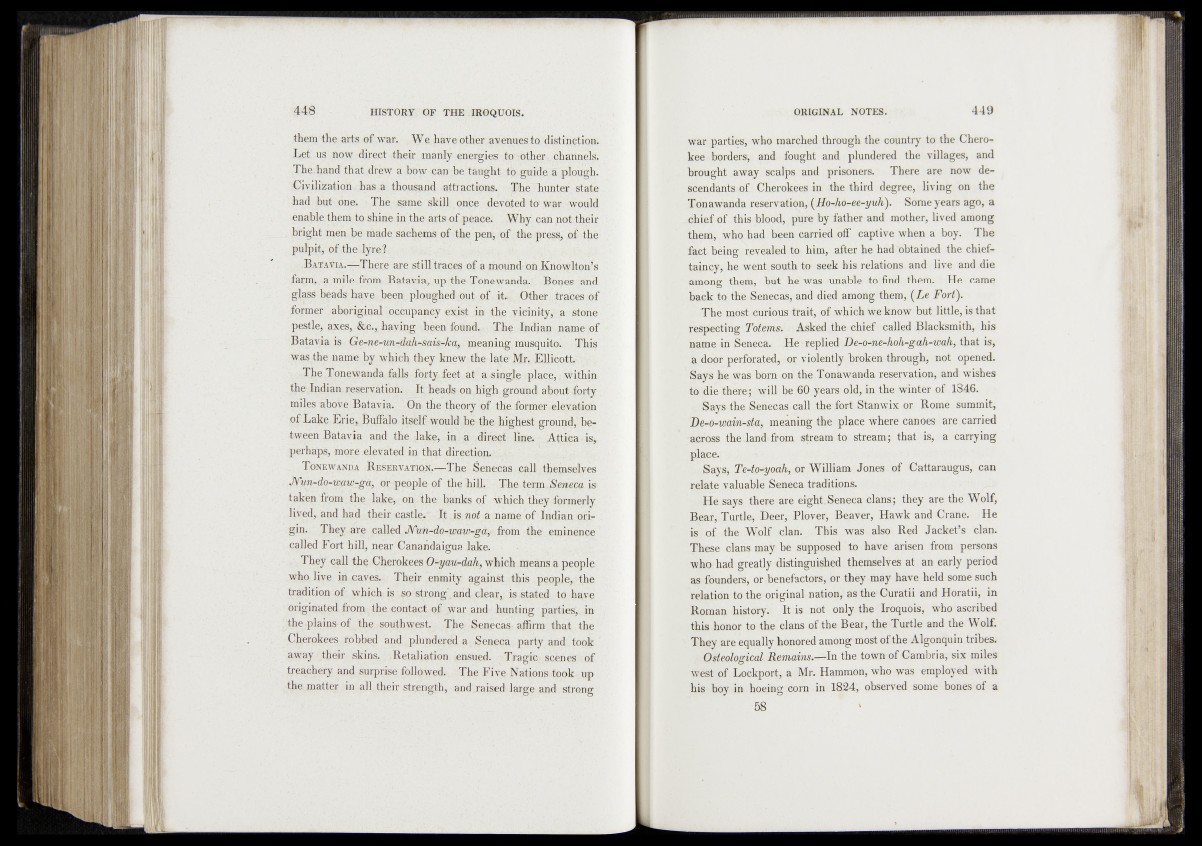
them the arts of war. We. have other avenues to distinction.
Let us mow direct their manly energies .to mther. channels.
The hand that drew a bow-can be taught to .guide a plough.
Civilization has a thousand attractions. f }he. buiiter state
had hut one. - The s.arne skill.;once devoted to' war would
enable them io shine in the arts of peace. Why can pot their
. bright men be made sachems of the pen, p f . the press, o£ the
pulpit^ of the lyrej,;
BataYia.—There are still traces of a mound-on i£noTyMen!s.
farm, a mile from Batavia,,up the Tonewanda. Bones and
glass beads have been ploughed out ef ite. Other traces p f
former aboriginal 'occupancy -e^ist in th,e vicinitycp stone
pestle, axes, &c., having been found. T-he Indian name of
1 Batavia is Ge^erun^rhA-’Sais.-kalf meaning, musquito. This
was the name by which they knew the late Mr. EIJicott.- ,,
The T-onewanda falls fortyifeet at a.single place,v within
the,Indian.reservation. _Jt, heads-on high ground-about forty
miles above Batavia. On the theory of the former elevation
pf Lake Erie* Buffalo itself would he the highest ground^,’'between
Batavia and tlie-lak.e, in a direct line. Attica is,
perhaps, more elevated in that directions .
T o n e w a n d a .R e s e r v a t io n .—--The1 Senecas ca ll. themselves
Nun-do-w<tw-ga, or people of the hill. The termAefeeca is-,
taken from.the lake, on the-banks qf Whjeh they formerly,
lived,, and had their-castle/" ft i s not a name of'Indian ori-
giu- They arp called JS^un^ripap-gd^ from the eminence
called Fort hill, near'Eanah daigue lake.,- - ■
They call the. Cherokees O-ynu-dah, which means a people '
who. live in .caves. Their enmity against this people,.’the
traditiqn of which is go strong s and cl£ar^ is stated to have
originated from the tcontact. of yvar arid hunting' parties in
the-plainaof the southwest. The Senecas affirm that the
Cherokees fobbed and plundered a: Seneca,. party and took '
away their skins. .Retaliation ensued. Tf agiCvseenes- bf
treachery- and surprise followed;. The Five Natibus-tobk up
the matter in all, their strength, and „raised - large and strong '
war parties, who marched through the country to the Cherokee
borders, and fought and plundered the villages, and
brought aWay scalps and prisoners. There are now descendants
of Cherokees in the third degree, living on the
Tonawanda reservation, (Ho-dio-ee-yuK). Some years ago, a
chief of this blood, pure by father and mother, lived among
them, wliq had been carried off captive when a boy. The
fqet being revealed to him, after he hadbbtained the chief?
tajney, he went, south to- seek his relations and live and die
among them, but he was unable to find them. He came
back to the Senecas, and died among them, {Le Fort).
The most curious trait, of which we know but little, is that
respecting Totems. Asked the chief called Blacksmith, his
name in Seneca, ’ He _■ replied - Be-o^ne-koh-gah-wah, that is,
U door perforated, or violently broken-through, not opened.
Says he was horn on,the Tonfcwanda reservation, and wishes
to die there-; will be 60 years" old, in the winter of 1846.
-, -Says the Steheoas call,the’fort.Stanwix or Rome summit,
Le-o^wam-sta, meaning the place where canoes are carried
mcross the .land from stream to stream; that is, a carrying
place. ;
8 ays, Te-to^yoah, or William Jones of Cattaraugus, can
relate valuable Sèneea traditipns. j .
He says there are eight.Seneca clans; they are the Wolf,
Bear, Turtle, Deer, Plover, Bepver, Hawk and Crane. He
is o f -the Wplf clan. This was also Rçd Jacket’s clan.
These clans, maÿ he supposed to have arisen from persons
who had greatly distinguished, themselves at an early period
as founders, ofbenefactors, or they may have held some such
relation to the original nation, as the Curatii and Horatii, in
Roman history. It is not only the Iroquois, who ascribed
this honor to the clans of the Bear, the Turtle and the Wolf.
They are equally honored among most of the Algonquin tribes.
Osteolpgical Memains.-r-^ln the town of Cambria, six miles
"west of Lockport, a Mr. gammon, who was employed with
his boy in. hoeing ;G©rn in 1824, observed some bones of a
58